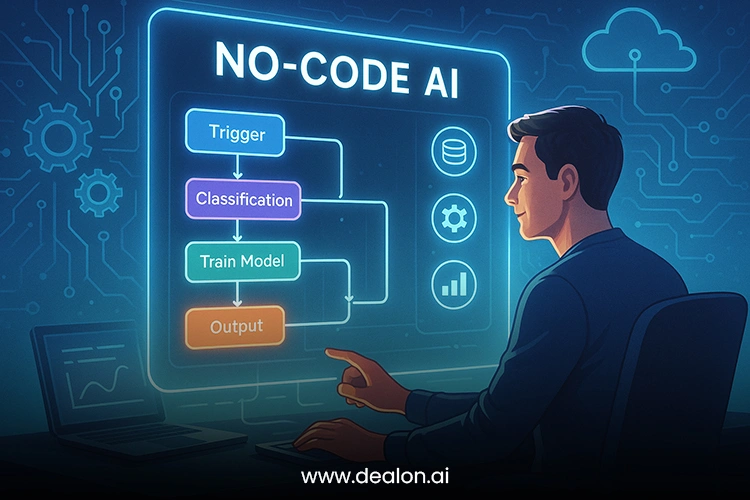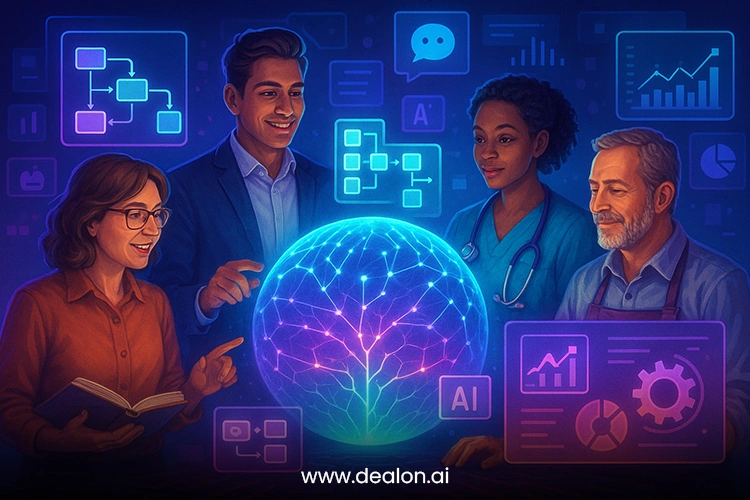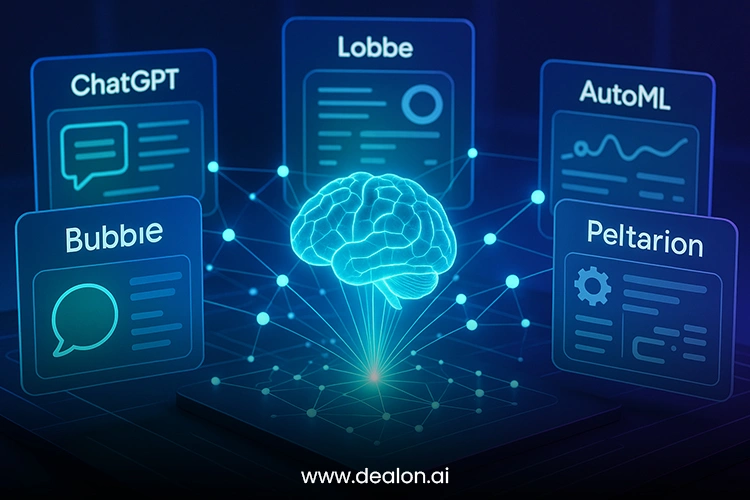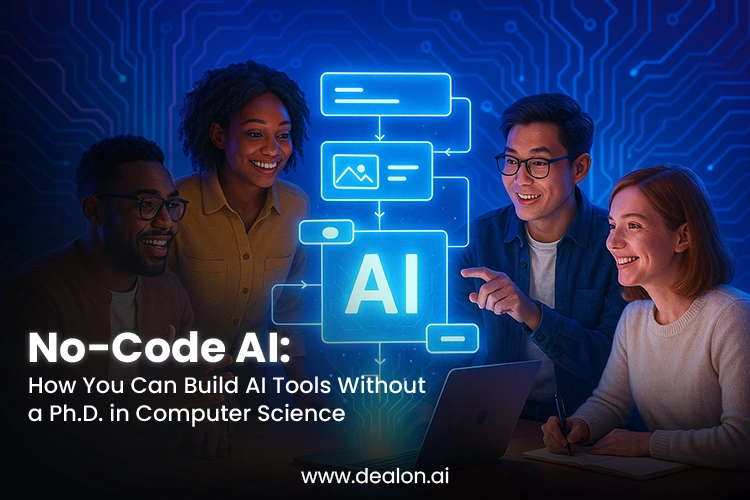Like everything else, technology has undergone continuous transformation, and the changes, although drastic, have widened the scope of its application. No longer is innovation the domain of a select few. With the inevitable shift, the world has moved towards No-Code Artificial Intelligence, and its application has spread its wings far beyond a single field. With the evolution of technology, the implementation and utility of complex Artificial Intelligence has shifted gears. Sophisticated algorithms are now within the reach of not only PhD scholars and engineers but also educators, entrepreneurs, marketers, and even creators whose primary skill is not coding. The fusion of technology and innovation has engendered a new paradigm shift.
Using intuitive pre-trained models, no-code AI employs visual interfaces to transform concepts into working models using drag-and-drop features. With no-code AI, working on programming languages and complex mathematical constructs becomes a thing of the past. The changes brought about by No-Code Artificial Intelligence are nothing short of revolutionary. With the newfound power, some may say, it is democracy in its purest form; it has a bolstering effect on individuals and institutions to solve challenges of the ever-growing complex world by tailoring solutions with immense speed and precision.
What makes this situation extraordinary is the ways it could change the way we do business. Startups can focus on prototyping new ideas in record time. Educators can help improve education. Companies of every size and shape can employ effortless AI integration for day-to-day operations without the need for technical teams or expensive solutions. In this era, we can already see how more and more, it is the creativity, problem-solving, and knowledge in the subject that is more useful than the knowledge of the code.
No-code AI is much more than the simple emergence of new technology. It signifies a complete change in cultural and economic paradigms. It is a change that is more about embracing innovative human ideas by removing all the access barriers. It is the change that is inviting more and more people to the AI innovation conversation. With this change, we see new possibilities; now, the people who can do it with an AI have expanded.
Also Read: Beyond the Prompt: How Advanced AI Reasoning is Delivering True Data
What is No Code AI?

No-code AI changes how Artificial Intelligence is created and used. It almost completely replaces extensive coding with more altruistic and accessible systems that allow the construction of intelligent systems with simple drag-and-drop interfaces, modular workflows, and varied templates. These systems have successfully eliminated the numerous programming, intricate, machine-learning related barriers and the mathematics to increase involvement in the AI ideas and innovations.
These tools allow the rapid transformation of untapped raw data into valuable and actionable information. Gone are the days of endlessly pondering neural network telemetry, disassembling the data science pipeline, or attempting to puzzle out the myriad of Python libraries. The user uploads the datasets, specifies the desired outcomes, and observes the system train and optimize itself. This shift is not in any way decreasing the AI’s capabilities; rather, it is increasing the population’s ability to access the tools if the user’s skill lies in basic web page construction or design applications like Canva.
What makes no-code AI a game-changer

Something New for Everyone
No-code AI’s most distinguishing feature is its availability. Teachers, healthcare professionals, small business owners, and others can now use AI technologies. This encourages the rapid development of niche tools and services from people who are not from the tech industry. For instance, a predictive analytics tool to estimate the amount of ingredients a local restaurant may need would be handy, or an artist who wants to design an AI that can suggest style alternatives would find this very useful. Advanced technology does not change based on its users, but the other way around.
Rapid Prototyping and Deployment
Using the traditional approach, each AI project would take several months to complete due to the repetitive cycles of experimentation, testing, and refining in order to achieve a prototype. With No-code AI, this method can be simplified into the concept of rapid prototyping. AI-driven tools allow business owners to validate business ideas and prototypes in a matter of days, and with little expenditure of both time and resources. This differentiation not only accelerates innovation but also strengthens the culture of experimentation where the only limits to ideas are the fancies of the creators, and not the financial costs. This results in a more dynamic, competitive, and agile marketplace where novel ideas are more openly shared and pursued.
Cost-Effectiveness
Tailored AI development systems needed time, money, and a workforce behind sophisticated technology. The no-code platforms simplified the process and provided economically viable solutions through subscription services and ready-made algorithms requiring only simple customizations. Startups and small companies that lacked the infrastructure, tools, and technology of AI superpowers can now compete at a lower price through AI-enabled intelligent resolvers. This widespread availability and affordability of tools fosters innovation that can rise from all corners of the world, rather than being limited to technology giants.
Think About the End Product, Not the Process
Building AI the conventional way tends to overcomplicate things and ends up losing sight of the primary goal. In the case of no-code AI, the solution is found, and the creativity takes off. Focus on the opportunities that create value for the users of the system. Go to the “The Value Cube” Presentation to the users, or find endless possibilities, and the system takes care of the coding and optimization complexity. You are able to gain greater cognitive value. You ideate and create value, which is very human-centric rather than providing an overly technical solution.
Some Well-Known No-Code AI Platforms

With no-code AI systems, the user does not need to concern themselves with the technical aspects of the system, and can freely work with the previously complex machine learning. The systems are versatile and serve the needs of almost every user, and require no technical complexities.
With the influx of tools, Chat GPT and OpenAI, businesses and people can find a new way to make use of human-based artificial intelligence. Companies that use the tools embedded in their systems and make use of custom assistants are able to effortlessly and automatically respond to client questions and create and polish work, offer automated and real-time guidance, and make executive decisions. Companies gain in user-tailored systems, automation, and responsiveness, and can personalize their systems.
With its new AI powers, Bubble enables users to build advanced applications as easily as dragging and dropping items. Predictive recommendation engines on e-commerce sites and scheduling applications that respond to user interaction are just two benefits of complex features being easily integrated into customized solutions on Bubble, with no coding required.
Microsoft’s Lobe takes a more hands-on AI approach as a visually based program. Its focus on image classification allows users to build and train models by dragging and dropping examples and later exporting them to apps like monitor systems in agriculture and assistant creatives. The ease of Lobe’s workflow is perfect for those venturing into computer vision with no technological experience.
Google AutoML provides a more structured approach to AI for users wanting to improve machine learning models without advanced knowledge. Models that predict, categorize, or identify anomalies can be built with less user supervision by uploading structured datasets to train them. Its ability to work with Google Cloud allows for AutoML to be used in large-scale enterprise situations.
Peltarion focuses on large-scale deployments while still having one of the simplest user interfaces. It gives businesses that require advanced features and large, robust solutions the ability to quickly and easily refine their models while still having them production-grade dependable. It is a perfect balance of ease and strength for real-world applications.
As a collection, these platforms showcase how no-code AI technology is decreasing barriers to entry while increasing the ceiling of possibility for content creation.
No-Code AI use Cases
The range of no-code AI is not limited to experimentation. It is already beginning to change entire sectors of the economy through practical use cases.
No-code AI chatbots are undoubtedly a necessity in customer support. These bots save time and provide instantaneous answers to repetitive questions. This reduces customer waiting time and increases customer satisfaction while helpdesk agents deal with complex problems. These AI bots are fully operational, hence helping firms support their clients globally without raising operational costs.
No-code AI is also successful in content creation. Businesses are now able to easily and consistently generate optimized blogs and compelling product descriptions. Small teams and startup firms are relieved of the content production burden and are able to shift their focus to other sectors, thus improving their competitive stance in the market.
Marketing concealment has become much easier with the help of AI predictive models, which segregate an audience, analyze purchasing habits, and manage a campaign all at once. These models can offer interpersonal approaches and tailored solutions that go beyond basic segmentation models. With no-code platforms within reach, small firms no longer need specialized data teams to gain insights previously reserved for big businesses.
In health, no-code AI platforms are helping design diagnostic systems and symptom checkers for non-emergency situations. These tools enable patients to assess symptoms and receive information on when to seek help. Such technologies are not meant to substitute professionals but instead improve the availability of services in underserved areas.
Education is similarly changing due to no-code AI systems, which personalize educational experiences using data from adaptive learning platforms. The wrong pace of instruction both leaves behind and overburdens learners. The old approach is now replaced with personalized portfolios, which improve understanding and full involvement of the learners.
These instances demonstrate the impact of no-code AI on various sectors. It speeds vision realization to help individuals and firms innovate more inclusively.
Tips to Get Started With No-Code AI
It is important to consider what you want to achieve. Goals will always be essential to building a strategy, no matter how big or small. It is not enough to go in with some foggy idea regarding AI; instead, what is the problem that you want to solve? Is it boosting customer satisfaction, automating some processes, or extracting knowledge from large amounts of data? Having a goal is crucial not only for purpose but also to take the appropriate measures to avoid wasting time and money.
The next important thing is choosing the right platform. Every no-code AI tool has its own features. Some tools specialize in building chatbots, some in vision AI, and some in Predictive analytics. It is better to choose a platform that fulfills the core needs of the business to optimize the development effort and maximize the benefits from it. A good example is a retailer looking for a way to forecast demand, which will likely use data solutions, for instance, AutoML, and a creative agency will use a program such as Bubble with AI plugins for building interactive applications.
Let us not forget the importance of data. The AI life cycle is built on the hinges of the information. If the system specifications are not met and are filled with inadequate, incorrect, or incomplete data, the result will always be a failure. In order for a system to predict and provide reliable information, refraining from biased data, curated, and relevant datasets is necessary. This is part of ethical AI use as it reduces the risk of unintended and harmful consequences.
The advances and drifts are foundational to any no-code venture of AI. Do not aim for perfection. Instead, pursue every prototype as something to learn from. Go, test, and repeat. This nimble way of working is the same way the big tech companies of the world operate—slow and steady wins the race. All innovations are the culmination of many more minor improvements.
Once again, the strongest value proposition is the deep integration of AI tools to activities beyond standalone value. When AI is added to Customer Relationship Management on websites and social media, it augments the way the user works, rather than being a standalone feature. The blended, unobtrusive augmentation of human efforts, powered by no-code AI, is of paramount importance.
The Future of No-Code AI
It is forecasted that the evolution of no-code AI will result in the restructuring of the relationship society has with technology. The focus will change from simply building more ingenious machines to providing individuals with the tools to utilize the machines in the most creative ways. No-code platforms will evolve from what is currently offered to provide powerful assistants that predict user requirements, intelligent business systems that change in real time to the environment, and generation systems that work with people in various forms of art, design, and storytelling.
Just like how website builders gave the power to the people and a participatory system, no-code AI tools will provide the power to the people to shape these technologies to their purposes. Thus, this shift will significantly change the balance of the competitive ecosystem. Disruptive innovators will come from this new paradigm, whether they are artisans, teachers, medical practitioners, or even businesspeople.
Final Thoughts
No-code AI tools are more than just a new technology convenience. They represent an innovation in thinking and technology, merging new dimensions. Barriers to no-code AI platforms open up space for creative expression, starting with an educator designing personalized lesson plans. They will also be able to access the power of advanced analytics tools previously available to big businesses.
These days, we have so many opportunities to step into the world of no-code AI. Platforms are advancing and changing every second; there is a growing need for problem-solving and intelligent solutions, and the opportunities to experiment are countless. There are no limitations aside from the limitations of one’s imagination. The pioneers of this exploration will not only use the technology but will also be the reason for the powerful AI world we will witness in the future.

